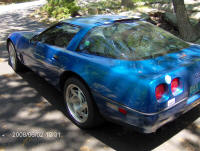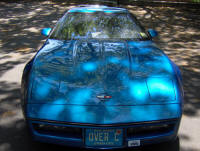RIKLBLOG
|
| Tomorrow |
| 15 Jan. 2009 |
| Yesterday |
| Index |
| Eventide |
| SETI League |
| PriUPS Project |
| Bonus! |
| Contact |


PriUPS Checklist
Sometimes Ice means Ice
It certainly has in New England and New Jersey, recently. My Prius is in the garage and is staying there for the simple reason that the slope out of the garage is ice covered. It would take a winch or several 50-lb bags of calcium chloride to get the car on the road. While we Prius fans often use ICE as shorthand for "Internal Combustion Engine" when discussing energy flows, the mainstream press has recently been talking about its much colder namesake, and a number of actual and would-be Prius owners have exhibited more than the usual curiosity about emergency power. I know this because my correspondence has increased substantially. To practice my usual "conservation of text," I shall answer a typical email publicly, below. But not without first offering a digression about "checklists."
The Checklist
The checklist has been much in the news lately as a lifesaving tool. For example, this article explains that "Adopting a surgical safety checklist reduced deaths and complications by more than a third in a study published online by the New England Journal of Medicine." But that checklist is meant to be used by surgeons. If I were looking for spurious items in an open body cavity, I would have trouble finding anything less obvious than a live chicken.
The Funky Pitot Tube Incident
One of the first things a pilot does before flying is to use a checklist to confirm that all is as it should be with the airplane, both internally and externally. One item on the list is to confirm that the Pitot tube has a clear opening. I duly followed the list, and started my takeoff run. I noticed that the airspeed indicator seemed to be reading very low, but by this time I was too far along to safely abort the takeoff and everything else felt right. Exercising (in the few seconds available) my judgment, I decided that everything was indeed OK with the aircraft and that the problem was the indicator itself. I continued the takeoff without incident.
The airspeed indicator continued to read much too low, but since I was flying, which is inconsistent with insufficient airspeed, it was clear that my earlier judgment was correct. On the other hand, since flying without an accurate airspeed indicator is a really bad idea, my next job was to land and diagnose the problem. In a small airplane in VFR weather, you fly as much by sound and feel as you do by instruments. Although flight training emphasizes the correct airspeed for each phase of the landing procedure, there is enough slop that if you err a bit on the high side, the result will likely be nothing worse than using a bit more runway than usual. (Erring on the low side can result in creating a small, shallow crater before you quite reach the runway.) Needless to say, I didn't die or even bend the airplane, and proceeded to further explore the problem. It seems that, although the Pitot tube looked entirely clear, a small insect had burrowed its way inside, beyond the visible opening, and clogged the tube. The checklist in this case was insufficient, and my (modest) experience as a pilot was enough to save the day.
As a result of this experience, I modified my own personal checklist: Before flying, I now blow into the Pitot tube, cover the opening with my finger, turn my attention to the airspeed indicator which should now be reading 50-100kt, and then release the pressure in the tube. The airspeed indicator should quickly decrease to zero; if it doesn't I know there's a constriction in the Pitot tube. My point here is that the checklist was both helpful, as I might have forgotten to check the Pitot tube at all, and insufficient, in that it didn't suggest using a borescope or my procedure to really check the Pitot tube. This is a characteristic of checklists: They make sure you don't forget an important step, but they're not complete and they are no substitute for experience (or for a good surgeon).
The Email From Bob
Hi Richard,
I just spent a couple of hours reading your website on building a Priups.
I found it to be very interesting and informative. What can you do
for me, you ask? :-)
Well, I am NOT electrically inclined at all. Most electricians I
know are not Prius inclined, it seems. So...would it be possible
for you to put out some sort of checklist/parts list that I could hand
to my electrician so I too can have a hybrid car emergency generator?
(Mine will be a CamryUPS.)
After our huge ice storm in New England last month there is a lot of
interest amongst my friends and coworkers on getting a little double
duty out of our hybrids. (If Toyota were smart they would market
this in areas like the Northeast.)
Also, now that gas is back down to the mid 1 dollar range, do you think
you might be able to finally fill in your fuel use chart? It's the
only missing link in your data, and dare I say, one of the most
important questions that non-electrophiles (is that a word?) like myself
would like answered. "How much will this cost to operate and how
long will a tank of gas power my house?"
Thanks Richard.
I get a great kick from reading about your hobbies.
Sincerely,
Bob
Bedford, NH
My Response To Bob
Hi, Bob!
Hours? You're a brave man!
A CamryUPS is a great idea. The Camry, as it turns out, has a battery voltage higher than the Prius but lower than the Ford Escape, and one almost ideal for powering the type of UPS I recommend. Yes, it would be possible to put up a checklist/parts list. Here it is:
-
Procure a UPS at an incredibly low price on eBay
-
Install a connector in the Prius (or Camry or other hybrid) and wire it to the UPS
-
Make a portable UPS system if you'd prefer not to do a full installation
-
For an installed UPS, get a professional electrician to wire the UPS to the house, as I did (or)
-
For a portable UPS, just run a heavy-duty extension cord to the appliances you want to run.
There, that was easy!
Or was it? If you read my checklist digression above, you'll know that without more experience, even using the links provided, you can't "just do it." For example, using the eBay "guide" on buying a UPS, you will still have to research models and manufacturers, deal with someone reputable, and do some testing to make sure it's all working OK. I could recommend some models (e.g., the HP/Compaq R1500XR and R3000XR which often are available) but then you would have to find the low voltage supplies needed to drive them. In other words, if you "are not electrically inclined at all," the project is fraught with peril. I might as well add this initial item to the checklist: "Have acquired many years of electrical experience."
I actually can offer some practical suggestions. The first, since you have friends and coworkers with hybrids, is to form a group and find someone, perhaps even in the group, who would be willing to take responsibility for planning it all. You can often get the parts needed on eBay in quantity, in which case the price is often even lower than "incredibly cheap." A second is to consider something like a kit. For example, if you search eBay for "Portable Backup Generator from a Prius" you will find a seller who is offering precisely that. I don't want to imply that this project is particularly difficult. It is not. But, short of writing a Heathkit-style manual and supplying the parts myself, I don't think I can proffer a parts list and installation guide beyond what I have on the PriUPS web site. If you do decide to go ahead, I hope you'll read the various cautions and caveats I have written, and that you will also send me pictures and a writeup for my "others" section that documents the PriUPS systems that this web site inspired.
You said that "If Toyota were smart they would market this in areas like the Northeast." Toyota is smart. Toyota isn't doing it. Yet. But I bet they will, eventually, in some form. I've also been trying to get inverter manufacturers to consider making a dedicated model for hybrids. No luck there, either. Yet.
Bob, I hope this has been somewhat helpful. I'd especially like to thank you for your email, which gave me the opportunity to answer future emails with a link to this blogitem.
Regards,
Richard
|
Special Advertising Section Please buy this lovely blue Corvette ZR1!
|
 |
NP: "New Toy" - Lene Lovich
| © 2009 |
| Richard Factor |
